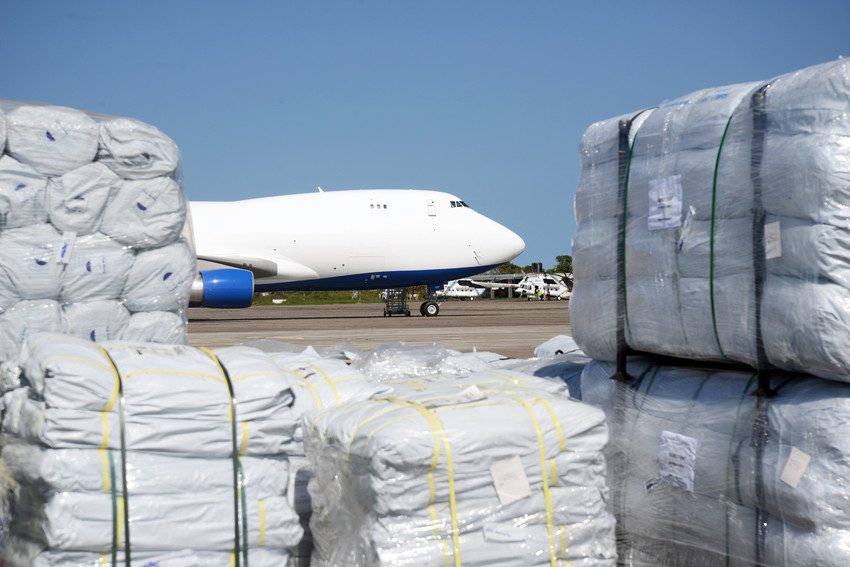Humanitarian supply chain guide
19 March 2024On the occasion of the European Humanitarian Forum 2024, Plan International publishes a short guide on what humanitarian supply chain is all about and why any funding gap discussions are incomplete without looking into this issue.

© Plan International, Mozambique, 2019. All rights reserved.
Supply chain and logistics are a crucial component of humanitarian response. As the European Humanitarian Forum 2024 is in full force and the funding gap is dominating discussions, Plan International publishes a short guide on the ins and outs of humanitarian supply chain.
Please click on each title to learn more.
What is the humanitarian supply chain?
Humanitarian supply chain refers to the planning, procurement, storage, transport and delivery of different forms of supplies, works & services used for projects and to respond to emergencies. This includes the flow of supplies from origin to destination but also more complex work including forecasting, optimising resources, value for money to ensure the most efficient process, and decreasing the carbon footprint related operations.
Why is humanitarian supply chain important?
Increasing humanitarian needs, unmatched by sufficient funding, require innovative ways of working, ways that generate more efficiencies, avoid duplication and increase the quality of goods and services by the aid ecosystem. Humanitarian organisations need to do more, often with less, in a world of changing geopolitical realities and shrinking humanitarian space. That is why humanitarians ask themselves how to do things better. Innovation and progress in supply chain are key in answering those questions.
Estimates indicate that around 60-80% of the cost of an emergency response is within the supply chain. A hulo report examining 30 humanitarian organisations calculated that more than $10 billion was spent on supply chains in 2022. This magnitude of human, organisational and financial resources clearly shows that related innovations and progress can have tremendous benefits for humanitarian responses and, ultimately, for people affected by crises.
Is procurement simply an administrative issue?
Procurement should not be understood exclusively through an administrative lens.
Procurement is power so it has the potential to transform lives in many ways, not only for the people humanitarian organisations buy for but also for the people we buy from. Local and sustainable procurement has a unique ability to shape the market and support local economies. It also has the ability to reach further and promote gender equality and empower women in their workplaces, in their communities, and through their purchasing policies and practices. Procurement also requires working in partnership with suppliers to demand better governance of procurement with the goal of creating an environment intolerant to criminal conduct, such as any form of modern slavery, corruption or bribery, and minimising or eradicating harmful environmental and social impacts. All in all, procurement is about economic, social & ethical power.
Our journey towards the Sustainable Development Goals cannot exclude procurement.
How is Plan International contributing to the evolution of humanitarian supply chains?
Plan International, conscious of the power behind supply chain, works to ensure that our processes are serving people to the best of our ability. To that end, Plan International technical experts are looking at an array of ways that our humanitarian supply chain can consistently improve. Among others:
- The first ever humanitarian logistics cooperative: Plan International is a founding member of hulo, the first humanitarian logistics cooperative. Capitalising on a cooperative business model, hulo is pooling resources and connecting actors by optimising costs and deadlines of the humanitarian supply chain. Indicatively, pooling procurement can generate savings up to 15%. The premise is simple: international NGOs compete in several spheres – supply chain should not be one of them. Any cost savings are reintroduced into the humanitarian response. The initiative, supported by the European Commission DG ECHO, is also behind the operation of EU Air Bridges that took place in 2020 in 21 countries worldwide, at a moment when COVID-19 demonstrated an unprecedented obstacle to humanitarian operations.
- Gender-responsive procurement: Gender-responsive procurement refers to the selection of services, goods and works that considers their impact on gender equality, women’s and young women’s empowerment. Plan International is introducing gender-responsive procurement processes across different parts of our procurement work, including in tender evaluation criteria, inclusive language, contracting and more. Our work is by no means done and we are only at the beginning of this journey.
- Localisation: Local and national civil society actors and local authorities play a range of essential roles in humanitarian response. Local actors are first responders, on the frontline of the response to protracted conflicts, and they often have access to and deep networks with affected people, legitimacy with communities and an in-depth understanding of the areas in which they work. Plan International is committed to supporting local actors to deliver their life-saving work and, currently, approximately 95% of all Plan International procurement is local. But going as close as possible to the point of impact has even more positive results, including decrease of environmental impacts and investments in local economy.


